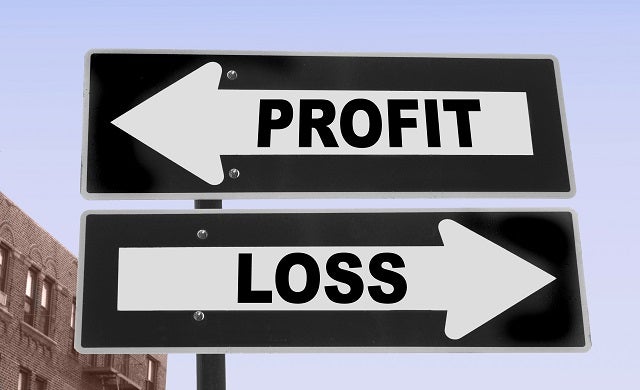For startups, revenue and profit are the key performance indicators (KPIs) that indicate success.
In recent years, we have seen investors pump billions into Silicon Valley or technology companies, based on projections and estimates. They catch the headlines and illustrate investors attempts to find the next company like Apple, but many fail without coming close to making profits and investors lose money.
During periods of economic uncertainty, investors like ‘real’ numbers. Actual sales, set against costs to deliver – hopefully – profits. Within this context, the profit margin is a vital number.
What is a profit margin?
Profit margins show the relative profitability of a company by illustrating the costs involved in producing and selling goods and services and the proportion of revenue that ends in profit.
Before we explain what a profit margin is, let’s clarify the different ways profit is expressed in financial statements, as startups will see these terms used for financial reporting purposes.
-
Gross Profit
Gross profit is a measure of profitability after deducting only the cost of making a sale from revenue. This does not include other non-trading costs required to calculate other profit measurements. It is a simple calculation and does not always reveal a full picture of the success or otherwise of a business.
Gross profit calculation
If a company generates £100,000 of sales and the cost of the goods it sells is £55,000, the gross profit is £100,000 less £55,000 = £45,000.
To calculate the gross profit margin, divide gross profit by revenue: £45,000/£100,000 = 0.45.
Then, multiply gross profit by 100 to get the gross profit margin: 0.42 x 100 = 42%
-
Operating profit
Operating profit is a measurement based on the profit after deducting all operating costs. It is also known as earnings before interest and taxes (EBIT). So, in addition to deducting the cost of sales, it also excludes some non-operating expenses including interest and taxes.
-
Net profit
Net profit is the most commonly used and probably the most important measure of profit. Otherwise known as EBITDA (earnings before interest, taxes, depreciation and amortisation), the measure strips out all regulatory costs and expenses related to running a business as a going concern.
The profit left after stripping out all these costs shows a true measure of a business’s profitability, revealing how much of a company’s net income is generated from revenue. EBITDA is usually what investors, competitors, customers and shareholders analyse to get a true picture of company performance, financial health and its potential for growth.
How do you calculate a net profit margin?
To calculate net profit margin requires a few more steps because, as explained above, you must deduct operating costs as well as the cost of goods sold. So:
Revenue, £100,000 – cost of goods £55,000 – operating costs, in this case £11,000 = £34,000 net profit.
You then divide net profit by revenue: £34,000/£100,000 = 0.34.
You then multiply net profit 0.34 x 100 = 34% is your net profit margin.
-
Profit margin
Profit margin itself measures the level at which a company makes money or is profitable. It is usually expressed as a percentage figure as in the example above. It illustrates the proportion of sales revenue compared to costs for a business or the amount by which revenue exceeds the costs of total sales and for net profit margin, operational and regulatory costs within a business.
Profit margin defintion
The profit margin represents the portion of a company’s sales revenue that it retains as profit, after deducing all costs.
So, if a company reports a 20% profit margin for a reporting period, it means it keeps 20p for each £1 of sales.
What does net profit margin reveal about a business?
Revenue is an important figure but what is even more important is to know the proportion of each £ earned that is profit. If the cost of sales is higher than total revenue, the business is losing money.
If you sell a range of products, it can be beneficial to calculate net profit and net profit margin for each sales line. This reveals what product lines are the most profitable and which ones require further attention.
Investors will pay close attention to profit margins before deciding to invest in your business. For them, a low profit margin can indicate that company sales are falling, poor decisions have been made or the business needs to reduce its costs.
What represents a healthy profit margin?
This is a key question and one that is important to understand. Profit margins vary considerably depending on the type of business, what sector it operates in and other factors including how much a company has spent on investment, company acquisitions and expansion.
In general, the higher the profit margin %, the better. If its too low, for instance below 10%, your business becomes vulnerable to changes within your market or reduced sales that could result in company losses.
However, what is considered a good profit margin varies by industry. When comparing profit margins, avoid comparisons with businesses from different sectors. It’s important to compare like-for-like.
The profit margin doesn’t tell the whole story
Quite often fast-growing companies, successful by many metrics, have some financial or key performance indicators (KPI’s) that can be seen as negative.
So, for startups, what represents a healthy profit margin depends on the sector they operate in and how much they are investing in future growth and business infrastructure that will enable them to earn more revenue, with lower operating costs to grow profit margin ratios over time.
Early-stage businesses and startups often need to invest initially to grow and reach a stage where they can take on bigger projects, employ specialist staff or open up new revenue streams. This takes capital, which, if not invested, would give the business higher profit margins earlier, but might not contribute as successfully to long-term growth and profits.
Investors, accountants and other key stakeholders in your business should understand this and be able to extrapolate the key information that shows the reality behind the numbers and whether the figures are healthy or not.
This is why investors and business owners need to be cautious in comparing profit figures and profit margins for different types and sizes of businesses operating in different sectors and at varying stages of development and growth.
Case studies: Auto Trader, Rightmove and Cazoo
Two very successful UK companies, Auto Trader and Rightmove have very high profit margins.
Auto Trader has successfully transitioned from a print classifieds business to an online model. Its latest accounts for the six months to September 2023 show an EBITDA profit margin of 71%, the same as for the corresponding period last year.
That is an extremely high profit margin. There are lost of reasons why Auto Trader is a successful business but the main reason for such a high profit margin is because as an online business it has low fixed costs, for premises and equipment.
Unlike its customers, the car retailers who advertise on its online portal. They pay for dealer showrooms, they buy the cars, refurbish them and pay Auto Trader ever increasing costs to advertise on its portal. They pay because Auto Trader gives them good results and commands 75% of all car buyers online viewing time in the UK.
Rightmove operates a similar model. Its last accounts revealed a profit margin of 73%. It has low fixed costs for similar reasons, running an online portal that estate agents feel compelled to pay ever increasing sums to each month to advertise their property listings on.
When consumers want to buy a house, they usually start their search on Rightmove, so for estate agents to get eyeballs on their listed properties, they need to be on Rightmove. In 2022, the company earned revenue of £332.6 million, less administrative costs of £91.3 million, resulting in operating profit of £241.3 million, at a margin of 73%.
It’s no wonder these two companies have a high share price and represent British success stories.
Online does not always work
But this does not mean all companies with a predominantly online business model will succeed.
It does show two companies who entered a growing online market at the right time to become dominant incumbents, using a business model proven to be popular with consumers. It also means their customers (car dealers and estate agents) can’t currently be as successful without them.
Another example, Cazoo, founded in 2020, tried to compete with established car dealers using a purely online model, but has largely failed.
You would think Cazoo, like Auto Trader and Rightmove, an online business with lower fixed costs would have healthy margins. But as it is not yet profitable, we can’t compare profit margins, but we can analyse profit ratios per units sold.
The company aimed to tap into the growth of online sales during the pandemic. Founder Alex Chesterman, who had a successful track record in setting up other online businesses such as LoveFilm and Zoopla, attracted hundreds of millions of pounds of investment from investors who bought into his vision.
However, the auto sector has proved a tough nut to crack.
Cazoo acquired over a dozen businesses in the UK, France, Germany, Italy and Spain, spending hundreds of millions to establish businesses in Europe’s five biggest markets but quickly backtracked when investors confidence ran out in 2022.
Cazoo sold its continental European businesses to focus on the UK, and in June 2022 announced a ‘realignment plan’ to save £200 million by the end of 2023 in a bid to reach break-even and improve its profit margins.
Cazoo’s gross profit per unit (GPU) history is revealing. In 2021, according to its financial statements, it made a profit of £427 per car sold. This declined in 2022 overall to £403 but as its cost-cutting measures took effect by Q4 2022, GPU increased to £600 per vehicle sold. This reached £1,290 per vehicle sold in Q2 2023.
This contrasts with a ‘bricks and mortar’ car supermarket, Group 1 Automotive UK, with higher fixed costs. At the time Cazoo had a GPU of £403, Group 1’s GPU for new car sales for the first nine months of 2022, according to its financial statements, was £3,149 and for used cars fell to just under £1,4
In summary
These case studies illustrate three important points about profit margins and how businesses and investors employ them:
- Not all businesses will be successful
- Different industries face separate challenges that can impact what represents successful financial results and profit margins
- Investors need to analyse businesses in-depth to get the full picture of what makes a business likely to succeed.
When it comes to the profitability of a company, that’s the bottom line.
Benjamin Salisbury – business journalist
Benjamin Salisbury is an experienced writer, editor and journalist who has worked for national newspapers, leading consumer websites like This Is Money and MoneySavingExpert.com, business analysts including Environment Analyst, AIM Group and written articles for professional bodies and financial companies. He covers news, personal finance, business, startups and property.
The post Profit margin: how to calculate it and what makes a good one? appeared first on Startups.co.uk.
Read the full article here




















